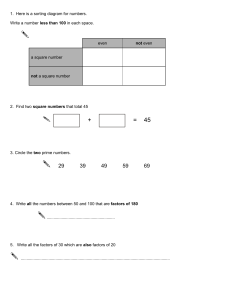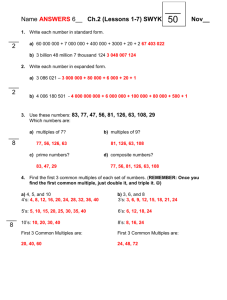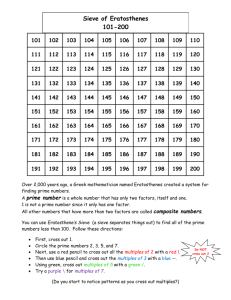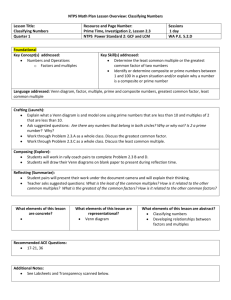Multiples, Factors and Prime Numbers
advertisement
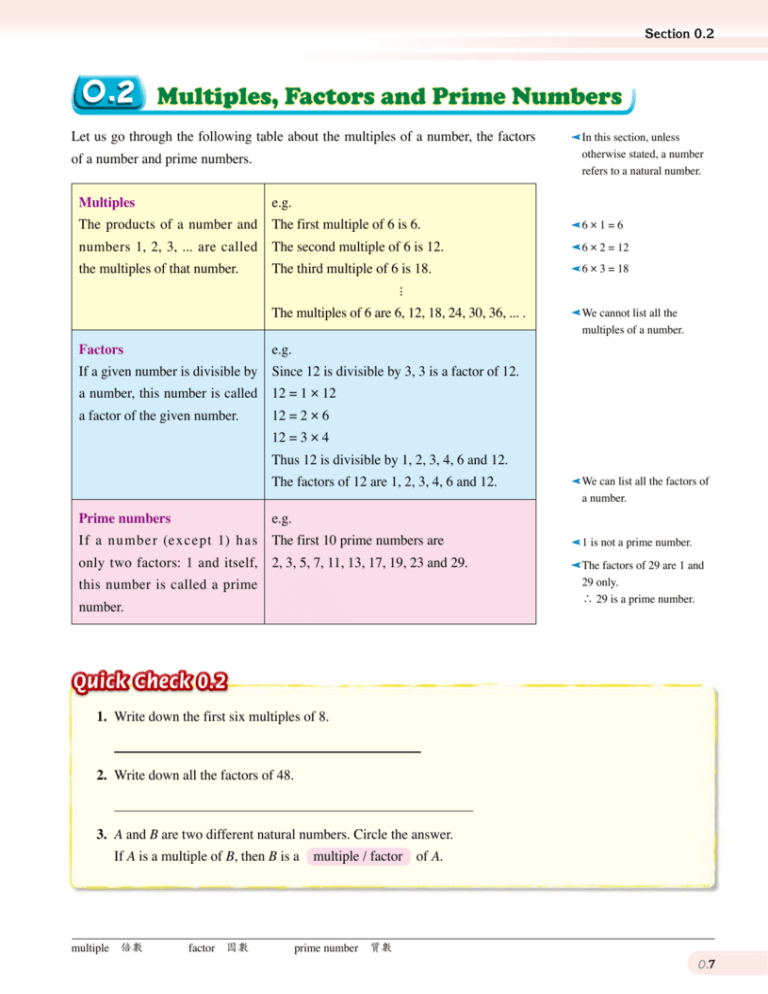
Section 0.2 0.2 Multiples, Factors and Prime Numbers Let us go through the following table about the multiples of a number, the factors of a number and prime numbers. Multiples The products of a number and numbers 1, 2, 3, ... are called e.g. The first multiple of 6 is 6. The second multiple of 6 is 12. The third multiple of 6 is 18. 6×1=6 6 × 2 = 12 6 × 3 = 18 ... the multiples of that number. In this section, unless otherwise stated, a number refers to a natural number. The multiples of 6 are 6, 12, 18, 24, 30, 36, ... . Factors If a given number is divisible by a number, this number is called a factor of the given number. e.g. Since 12 is divisible by 3, 3 is a factor of 12. 12 = 1 × 12 12 = 2 × 6 12 = 3 × 4 Thus 12 is divisible by 1, 2, 3, 4, 6 and 12. The factors of 12 are 1, 2, 3, 4, 6 and 12. Prime numbers If a number (except 1) h a s only two factors: 1 and itself, this number is called a prime We cannot list all the multiples of a number. e.g. The first 10 prime numbers are 2, 3, 5, 7, 11, 13, 17, 19, 23 and 29. number. We can list all the factors of a number. 1 is not a prime number. The factors of 29 are 1 and 29 only. ∴ 29 is a prime number. Quick Check 0.2 1. Write down the first six multiples of 8. 2. Write down all the factors of 48. 3. A and B are two different natural numbers. Circle the answer. If A is a multiple of B, then B is a multiple 倍數 factor 因數 multiple / factor of A. prime number 質數 0.7 Chapter 0 Class Activity 0.2 The following table shows the numbers from 2 to 100. Jason wants to use the following method to find all the prime numbers between 2 and 100. He considers the numbers from the smallest to the largest. Starting by the first number ‘2’, he circles ‘2’ and crosses out all other multiples of 2. 1. 2 3 4 5 6 7 8 9 10 11 12 13 14 15 16 17 18 19 20 21 22 23 24 25 26 27 28 29 30 31 32 33 34 35 36 37 38 39 40 41 42 43 44 45 46 47 48 49 50 51 52 53 54 55 56 57 58 59 60 61 62 63 64 65 66 67 68 69 70 71 72 73 74 75 76 77 78 79 80 81 82 83 84 85 86 87 88 89 90 91 92 93 94 95 96 97 98 99 100 Objective To find the prime numbers between 2 and 100. Follow the procedures below to help Jason circle or cross out the numbers. (a) Circle the next number which has not been crossed out. Then cross out all other multiples of this number. (b) Repeat the procedure in (a) until each number between 2 and 100 is either circled or crossed out. All the numbers which are circled in the table are prime numbers between 2 and 100. Complete each of the following. 2. There are 3. Within the numbers between 2 and 100, the smallest prime number is number is prime numbers between 2 and 100. . Eratosthenes (276 – 195 BC) was a Greek mathematician. He invented a method for finding prime numbers. The method is known as the Sieve of Eratosthenes. In Class Activity 0.2, we have found all the prime numbers between 2 and 100 by this method. Sieve of Eratosthenes 愛氏篩 0.8 and the greatest prime Section 0.2 Consider the numbers 8 and 12. The multiples of 8 are 8, 16, 24, 32, 40, 48, 56, 64, 72, ... . The multiples of 12 are 12, 24, 36, 48, 60, 72, ... . Note that 24, 48 and 72 are the first, the second and the third common multiples of 8 and 12 respectively. Among all the common multiples of 8 and 12, 24 is the smallest. Advice 24 is called the Least Common Multiple (L.C.M.) of 8 and 12. The least common multiple of two numbers is the first common multiple of them. The factors of 8 are 1, 2, 4 and 8. Advice The factors of 12 are 1, 2, 3, 4, 6 and 12. Note that 1, 2 and 4 are the common factors of 8 and 12. Among all the common ‘1’ is always the least common factors of two numbers. factors of 8 and 12, 4 is the greatest. 4 is called the Highest Common Factor (H.C.F.) of 8 and 12. Challenge Level 1 Example 0.4 Find the H.C.F. and the L.C.M. of 18 and 24. Challenge Solution The factors of 18 are 1, 2, 3, 6, 9 and 18. Explain why we cannot find the highest common multiple of any two numbers. The factors of 24 are 1, 2, 3, 4, 6, 8, 12 and 24. The H.C.F. of 18 and 24 is 6. The multiples of 18 are 18, 36, 54, 72, 90, ... . The multiples of 24 are 24, 48, 72, 96, 120, ... . The L.C.M. of 18 and 24 is 72. Practice 0.4 Find the H.C.F. and the L.C.M. of 15 and 20. Exercise 0.2: 5 – 6 Class Exercise 0.2 1. Find the first three common multiples of each of the following pairs of numbers. (a) 3 and 8 (b) 7 and 10 2. Find the L.C.M. of each of the following pairs of numbers. (a) 9 and 15 (b) 20 and 25 3. Find the H.C.F. of each of the following pairs of numbers. (a) 45 and 30 Least Common Multiple (L.C.M.) 最小公倍數 (b) 60 and 180 Highest Common Factor (H.C.F.) 最大公因數 0.9 Chapter 0 Exercise 0.2 Level 1 1. Write down the first five multiples of each of the following numbers. (a) 4 (b) 7 (e) 22 (f) 50 (c) 9 (d) 17 2. Write down all the factors of each of the following numbers. (a) 16 (b) 27 (e) 54 (f) 90 (c) 35 (d) 42 3. Write down all the prime numbers less than 50. 4. Find the first three common multiples of each of the following pair of numbers. (a) 3 and 7 (c) 5 and 15 (b) 4 and 12 (d) 16 and 24 5. Find the H.C.F. of each of the following pairs of numbers. (a) 8 and 20 (b) 24 and 32 (e) 60 and 225 (f) 72 and 180 (c) 48 and 64 (d) 14 and 70 6. Find the L.C.M. of each of the following pairs of numbers. (a) 9 and 12 (b) 14 and 21 (e) 20 and 32 (f) 39 and 78 (c) 10 and 45 0.10 (d) 18 and 30 Example 0.4 Section 0.2 Level 2 7. Write down the multiple of 6 that is closest to 100. 8. Write down all the prime numbers between 100 and 130. Determine whether each of the following is true (T) or false (F). (9 – 13) 9. The least multiple of 90 is 90. 10. The greatest multiple of 90 is 900. 11. The greatest factor of 90 is 90. 12. The least factor of 90 is 2. 13. The product of all the factors of a prime number is equal to the prime number. 14. The H.C.F. of two numbers is 1. If one of the numbers is 21, which of the following CANNOT be the other number? A. 23 B. 27 C. 32 15. The L.C.M. of two numbers is 20. If one of the numbers is 10, which of the following CANNOT be the other number? A. 4 B. 5 C. 20 16. Alice finds that 36, 54 and 72 are three common multiples of 6 and 9. She says that since 36 is the smallest among the three common multiples, 36 is the L.C.M. of 6 and 9. Do you agree? Explain your answer. n-en Ope d de 17. Write down two numbers such that their H.C.F. is 15. n-en Ope d de 18. Write down two numbers which are greater than 1 such that their L.C.M. is 24. 0.11

